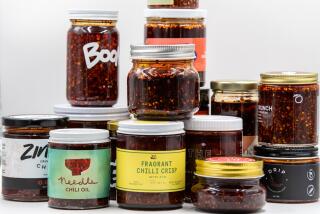The Chilemania Story : Chiles: The ultimate metabolic thrill ride.
- Share via
Chiles are wild. A number of species still grow without human help in numerous places between northern Mexico and northern Argentina, and they are among the hottest chiles there are. At least four totally wild species of peppers are still gathered and sold in South American markets. A proper Peruvian shish kebab ( churrasco criollo ) has to be made with wild chiles.
Chiles are extreme. Some are so pungent they can be tasted (and even smelled) when diluted hundreds of thousands of times in water. They’re all densely packed with nutrition: A fresh pepper has almost as much Vitamin A as beef liver and is second only to rose hips and acerola in the Vitamin C department. Chiles are also a hangover cure, an aphid repellent, a test of will and a thrill ride for the metabolism. The Aztecs used to fumigate their homes for rats by burning chiles.
And chiles are hot. We’re living in flavor-mad, nutrition-obsessed and, consequently, chile-oriented times. Robert Spiegel, editor of Chile Pepper Magazine, points out that all the food crazes of the past decade--Cajun, Caribbean, Thai, Southwestern and so on--use chiles freely, and part of the reason is that people who are cutting down on meat and salt usually add flavor to their food with spices. (Chile also has an unexpected benefit for people who are increasing the proportion of grain in their diet; it stimulates the enzyme amulase, which begins the digestion of starch.)
Chile is altogether amazing. Is it a spice? Is it a vegetable? (What other spice can you stuff with shrimp and cheese?)
The people of the Americas began eating chiles four or five thousand years ago. You have to wonder how they ever started--every other mammal gives the chile pod a wide berth. Probably they operated on the same theory that inspired great-grandmother’s spring tonic, the idea that anything with a fierce flavor has to have medicinal powers.
Whatever their reasons, they soon found that chiles are habituating. Over the course of a meal, you become less sensitive to the burn--and over the course of your lifetime as well. The more chile you eat, the less it bothers you, and ultimately the more you want.
We know they were eating peppers thousands of years ago because Mexican and Peruvian archeological sites dating back to 2,000 BC contain chile pods that show signs of domestication. Wild chiles are small and stick up above the leaves of the plant so birds can see them--in the wild, birds are the ones who spread chile seeds. We can tell from the shape of the ancient chiles that these had already been bred to ripen below the leaves, safely hidden from birds.
Only after that could people start breeding larger peppers. Since the wild chiles are all extremely hot (apparently the way birds like them), there was little need to develop hotter chiles. Generally speaking, larger peppers reflect a taste for a milder, more vegetable-like chile. This is still the rule of thumb in sizing up an unfamiliar pepper: If it’s small, it’s almost certainly the old-fashioned red-hot kind.
By the time of the Aztec and Inca empires, chiles were an essential part of civilized life. The Incas had a legend that the city of Cuzco was established by the First Inca, Manco Capac, with the help of his brothers Cachi (salt), Sauca (pleasure) and Uchu (chile).
Partly because of these thousands of years of breeding, and partly because domesticated chiles easily cross-pollinate with each other, peppers vary greatly in size and shape. At the turn of the century, botanists had categorized hundreds of peppers by the size and shape of their fruit and were running out of names.
Eventually they realized the varieties were not different species but the result of cultivation, and they decided to categorize them according to the color and structure of the chile flower. On that basis they concluded that there were only five distinct species. By far the best known is Capsicum annuum , the species that was domesticated in Mexico and has spread throughout the world. Nearly every pepper you can think of belongs to this species.
However, New Orleans hot sauces contain the Tabasco pepper of the semi-wild, very hot species Capsicum frutescens , native to Central and South America. And lately, hot-pepper fanatics have abandoned their loyalty to the jalapeno in favor of the very much hotter chile habanero of the Caribbean and lowland South America, also known as the Scotch bonnet pepper. It belongs to a species closely related to Capsicum frutescens , C. sinense (or C. chinense-- botanists seem to wobble on this).
But there are other species native to South America we haven’t seen at all yet. Capsicum baccatum , grown on either side of the Andes, can be told from any other because it is the only chile with a spotted flower. Capsicum pubescens , grown in the Andes themselves, is the only chile plant covered with a fine, downy hair (it’s also the only chile not found in the wild--it survives only due to human cultivation). Most of the South American chiles are much hotter than anything currently eaten in this country--though the way things are going, it’s only a matter of time.
When Columbus found chiles in the Caribbean in 1492, he thought they were a form of black pepper. He brought them back to Spain, and it was immediately discovered that unlike black pepper, which needs a specific rain forest climate to grow, chiles will flourish just about anywhere. There was a worldwide explosion of chiles in the 16th Century.
We can see how they spread just by looking at the words people use for them. In Indonesia, the native spice chabai --a relative of black pepper--practically fell out of use and chiles took over its name. The same happened in West Africa; indigenous spices such as Xylopia aethiopica faded away and left only their name ( kani in Guinea, ndu - ngu in the Congo), to the victorious new spice. In European, Near Eastern and East Indian languages, the old word for black pepper was taken over, though the victory was not so complete. I mean, we still do use black pepper, despite its lack of vitamins.
But it was a pretty great victory. West African, Southeast Asian, Indian and Sichuanese cuisines are unthinkable today without chiles, to say nothing of Cajun, Caribbean and Hungarian. Chile is the most widely grown spice there is.
Or is it a vegetable?
More to Read
Sign up for Essential California
The most important California stories and recommendations in your inbox every morning.
You may occasionally receive promotional content from the Los Angeles Times.










